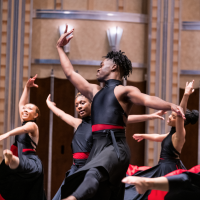Despite the universal wringing of hands and gnashing of teeth over the economy, recent articles in Philadelphia and Chicago newspapers indicate that arts organizations in those cities are weathering the financial storm pretty well. An article in the Plain Dealer quite a few months ago suggested the same thing about Cleveland groups (although the economy has gotten a lot worse since then).
Some say the arts always do well in tough times because people need to be entertained and to escape. Others are saying the arts are supremely qualified and positioned to weather financial stormy weather because they are so used to cutting back and operating on the proverbial shoestring – this is nothing different for them.
In looking at the arts locally, we cannot ignore the good fortune and the wise preparation for this icy financial climate that is unique to Cleveland arts. For the past 10 years, the Cleveland Foundation has focused on strengthening the core operations, business savvy, and financial risk-capital for a core of local arts organizations. We have invested more than $16 million to boost the financial and business capacity of more than a dozen established cultural organizations and supported the stabilization plans of many others. As a result, many of our arts groups are smarter, more efficient, better prepared, and more nimble than those in other major cities.
In counting our blessings, we cannot ignore the timely passage of Issue 18, which at long last (nearly 30 years behind other major metropolitan areas) brought Cleveland into the circle of the 50 largest cities in providing local public support for its arts. Actually, Issue 18 moved Cleveland overnight from outside that circle into the top 10.
And the country will begin to take notice of Cleveland artists in a whole new way when the individual artist fellowship grants program rolls out under the Community Partnership for Arts and Culture’s (CPAC) able management – to say nothing of the real and significant benefit to working artists that these grants will provide for the first time ever.
These awards (40 of them for $20,000 each across all arts disciplines) will be among the largest provided through any local arts council. They will be larger that those granted by many well-known private foundations that specialize in the arts. And they will happen every year for the next 10 years. What a way to boost the creative brain trust of the community.
I also want to note that, should President Obama’s desire to add $50 million to the budget of the National Endowment for the Arts be successful, the Ohio Arts Council (OAC) is well positioned to take advantage of some of the additional millions. The OAC recently received the highest ranking of all the state arts agencies from the NEA in assessing the quality of its grant applications. In addition, according to CPAC President Tom Schorgl, who sits on the OAC board, Ohio has many “shovel-ready” arts programs that address the federal government’s goals for this funding.
Finally, we cannot ignore the incredible continuing generosity of local philanthropy and particularly individual patrons of the arts, who are legendary in their support of our cultural community. At a recent meeting sponsored by Ohio Grantmakers Forum, funders on the panel (including the Cleveland Foundation) were clear that the arts continue to be an important part of the community, deserving of support even in tough times.
I don’t mean to paint too rosy a picture. There will be challenges, to be sure. Some projects will be put on hold and others will take longer to complete. Arts organizations will look to strengthen and streamline rather than step out into new ventures. Funders will be making hard decisions and I expect we will see some consolidation and reduction in the number of smaller arts groups.
But I do want to acknowledge the overall strength and resiliency of our arts community and note that it is well positioned to weather these stormy times. It will continue to be an outstanding intellectual, educational, economic, and vibrancy asset for this community as we go through and eventually come out the other side of this cold financial season.


